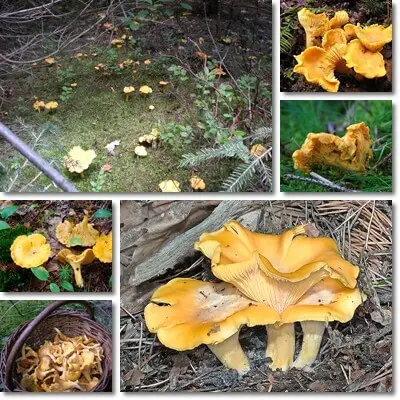Chanterelles are a variety of edible mushrooms sourced mainly from the wild. They have a particular appearance, often bright golden yellow-colored and funnel-shaped, and a distinct taste profile with earthy, peppery flavor notes and a faint peach-like scent. Chanterelle mushrooms are a great source of nutrition, boasting important amounts of several B vitamins, vitamin D, iron, manganese, phosphorus, potassium and, according to some sources, also vitamin C. At the same time, they can elicit side effects such as allergic reactions and gastrointestinal upset and can be a source of heavy metals.
The common name ‘chanterelle’ is actually used to denominate a wide range of edible wild mushroom species belonging to the Cantharellus, Craterellus, Gomphus and Polyozellus genera. The species in the Cantharellus genus are the most sough-after and readily available world-wide. Cantarellus cibarius or the golden chanterelle is one of the most popular species of edible chanterelle mushrooms in Europe. Cantharellus californicus, C. cascadensis, C. formosus, C. roseocanus, C. subalbidus are some of the most popular species in North America.

What do chanterelle mushrooms look like? Chanterelles are trumpet or funnel-shaped, with a more or less prominent depression on the cap right above the stipe or stalk. The cap is smooth on top and deeply ridged underneath, with a gill-like appearance. In young mushrooms, the cap is convex, with soft, regular margins pointing slightly downwards. As the chanterelles mature, the cap becomes funnel-shaped with irregular, wrinkly, lobed or even wavy margins. The stipe or stalk is robust, firm and smooth. Color is typically golden-yellow, with variations such as pale yellow, creamy white, orange-yellow or even red. On the inside, the mushroom is light-colored, usually white in color.
Less typical colors include: orange-brown, brown, lilac, dark purple-black, dark violet, dark grey or black. The mature chanterelle has a cap width ranging from 8 to 30 cm and can reach heights of of 7-17 cm, depending on the species. There are smaller species such as Cantharellus minor which grows to about 4 cm in height and has a cap of only 3 cm in width. The species Cantharellus californicus can reach impressive sizes, with specimens weighing as much as 1 kilogram.
What do chanterelle mushrooms taste like? Overall, chanterelles do not have a lot of flavor, nor is it rich or intense. Like most mushrooms, they are actually mild-tasting at most, with light earthy, herbaceous notes and a slight peppery flavor. They don’t actually have a fruity taste, but rather a faint apricot or peach-like aroma or scent. Which some people don’t perceive at all. You might notice some peach-like fruitiness if you keep chanterelles in a closed paper bag for a few minutes – so that the scent can build up in the bag. Chanterelle mushrooms have a pleasantly firm, meaty, chewy texture, with the cap being softer and the stipe or stalk more fibrous. Of course, not all species will taste exactly the same. Mushroom variety, age, amount of rainfall are just a few of the factors that account for differences in taste profile.

Nutrition facts
Nutrition facts determined for 100 g of raw mushrooms:
Energy value: 32 kcal/100 g
Carbohydrates: 6.86 g
Sugars: 1.16 g
Fiber: 3.8 g
Protein: 1.49 g
Fat: 0.53 g
Vitamin B2: 0.215 mg out of 1.3 mg RDI, recommended daily intake
Vitamin B3: 4 mg out of 16 mg for men and 14 mg for women
Vitamin B5: 1.075 mg out of 5 mg
Vitamin D: 5.3 mcg (micrograms) out of 15 mcg in the form of ergocalciferol (vitamin D2)
Iron: 3.47 mg out of 18 mg RDI, recommended daily intake
Manganese: 0.286 mg out of 2.3 mg for men and 1.8 mg for women
Phosphorus: 57 mg out of 700 mg
Potassium: 506 mg out of 4.7 g (or 4700 mg)
Zinc: 0.71 mg out of 11 mg for men and 8 mg for women
Chanterelle mushrooms also contain trace amounts of vitamins B1, B3, B9, calcium, copper, magnesium, selenium, sodium, but usually no vitamin C and no vitamin K. However, there are some sources that claim chanterelles are actually high in vitamin C which would add to their nutritional status and health benefits (source: Chemical Composition and Biological Properties of Portuguese Wild Mushrooms: A Comprehensive Study by Lillian Barros, Bruna A., Venturini Paula, Baptista Letícia M. Estevinho, Isabel C. F. R. Ferreira. Published in the J. Agric. Food Chem. 2008).
What are the benefits?
Eating chanterelle mushrooms as part of a varied and balanced diet contributes to meeting nutritional requirements and can be a source of benefits for metabolism and weight management, blood pressure, the digestive and immune systems, muscles, skin and bones. Here are some of the benefits:
1) Good food for weight loss. Chanterelles are a good option for a weight loss diet. They are low in calories (only 32 kilocalories per 100 g), fat (only 0.5 g) and sugar (only 1.16 g).
2) Constipation relief. Chanterelles are an excellent source of dietary fiber: 3.8 g of fiber per 100 g of raw mushrooms. A sufficient fiber intake improves transit time and promotes bowel movements regularity.
3) Boost in energy levels and vitality. Being a great source of several B vitamins, notably vitamins B2, B3, B5 and B6, the chanterelle contributes to elevated energy levels. A serving of 100 g of the raw mushroom provides about 25% of the entire recommended daily intake, RDI of iron and a boost in vitality.
4) Supports the immune system. The chanterelle is one of the few foods high in vitamin D. A serving of 100 g of the raw mushrooms provides 5.3 mcg (micrograms) of vitamin D out of the recommended daily intake of 15 mcg. The vitamin D in the mushrooms is in the form of ergocalciferol (vitamin D2) and holds immune system-modulating benefits.
5) Benefits for fertility. The excellent amounts of vitamin D in chanterelle mushrooms hold benefits for both female and male fertility. In women, vitamin D has a positive effect on progesterone and estrogen metabolism and increases pregnancy rates. In both men and women it helps regulate hormone metabolism with positive implications for conception rates.
6) Antioxidant properties. Chanterelle mushrooms contain good amounts of iron (25% of RDI) and manganese (close to 15% of RDI). The two dietary minerals work as co-factors for the superoxide dismutase enzyme, a powerful antioxidant enzyme that scavenges free radicals and protects against oxidative stress and associated diseases.
7) Anti-anemia food. A serving of 100 g of raw chanterelle mushrooms provides 25% of the recommended daily intake of iron, over 16% vitamin B2, 25-27% vitamin B3 and around 25% vitamin B5. Consumption helps correct nutritional deficiencies and prevent anemia and associated symptoms such as fatigue caused by iron or B vitamins deficiency.
8) Benefits for blood pressure and muscle. Chanterelles are rich in potassium, providing over 500 mg of the dietary mineral and electrolyte out of a recommended daily intake of 4700 mg, or 4.7 g. Potassium balances sodium, counteracting its water retention effect, as well as relieves pressure in the blood vessels, with direct benefits for high blood pressure. As a result of its electrolyte properties and role in regulating nervous system activity, it helps combat painful muscle cramps and spasms.
9) Benefits for bones. Phosphorus and vitamin D in chanterelles help maintain strong healthy bones and teeth. Potassium further benefits bone health: it balances acids in the blood and helps maintain the natural pH of the blood, preventing self-regulating mechanisms that draw out calcium from the bones.
10) Benefits for skin. Chanterelle mushrooms stand out as a great source of several B vitamins which actively promote skin health. Antioxidants such as vitamin D and carotenoids such as beta-carotene and canthaxanthin act as free radical scavenging agents and protect against oxidative stress and associated skin damage.
11) Good for eyesight. Bioactive antioxidant carotenoids in golden-yellow chanterelle varieties hold important benefits for eyesight. Most golden-yellow varieties have beta-carotene, a fat-soluble pigmented antioxidant and vitamin A precursor which promotes eye health. Orange-red varieties such as such as Cantharellus cinnabarinus contain canthaxanthin, a carotenoid without vitamin A activity, but with antioxidant properties. For the antioxidant carotenoids to be taken up by the body and used for promoting good health, the mushrooms need to be eaten with a source of fat.
Side effects and contraindications
Chanterelle mushrooms can be a source of side effects for some consumers.
1) Allergic reactions. Although rare, allergic reactions are possible and typically manifest as hives (red, itchy, bumpy skin), difficulty breathing (wheezing, swelling of the tongue, throat or lips), low blood pressure, fainting and anaphylactic shock – a medical emergency requiring immediate medical attention.
2) Gastrointestinal discomfort. General stomach upset, nausea, vomiting sensation, painful abdominal cramps, flatulence, loose stools and diarrhea are possible side effects. However, if symptoms are severe and do not subside, you might want to entertain the idea that the mushrooms you’ve eaten might not be true chanterelles, but inedible and possibly poisonous look-alikes such as the false chanterelle, Hygrophoropsis aurantiaca or the jack-o’-lantern mushroom, Omphalotus olearius. If you are not a seasoned forager, it might be best to avoid picking mushrooms by yourself.
3) Heavy metal accumulator. Studies show mushrooms take up heavy metals and all sorts of contaminants from the soil they grow in. Chanterelles may accumulate various contaminants too, depending on the quality of the soil they grow in and their native area which may be contaminated or not.
